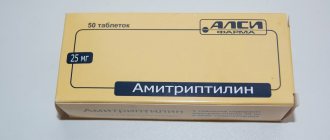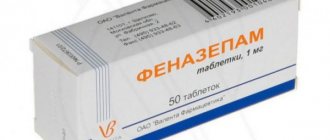Release forms, composition (active ingredient)
Amitriptyline is available as embonate or panamine hydrochloride. It belongs to the group of tricyclic compounds and has antidepressant activity. It is a white crystalline type powder. It has no characteristic odor and is highly soluble in ethanol, water and chloroform.
Amitriptyline tablets are produced in 25 mg and 10 mg doses, which corresponds to the amount of active substance in 1 tablet. To maintain the form, talc, cellulose, magnesium stearate, lactose in the form of monohydrate, silicon dioxide and starch are added to the preparation. For faster effects, there are Amitriptyline injections. The injection solution additionally includes dextrose monohydrate, sodium hydrochloric acid, purified water, benzethonium and sodium chloride.
The medicine has several therapeutic effects. These include antidepressant, thymoleptic, anxiolytic and sedative (sedative) effects. They are achieved by blocking the reuptake of serotonin and norepinephrine, which act as neurotransmitters. As a result, they accumulate and their effect on the nervous system increases. To enhance the effect, the drug inactivates histamine and m-cholinergic receptors, thereby improving brain function.
Amitriptyline analogues
Structural analogues of Amitriptyline are:
- Amizol,
- Amirol,
- Saroten,
- Tryptisol,
- Elivel.
In addition, there are other antidepressant drugs. The group of tricyclic antidepressants also includes imipramine and clomipramine. However, of course, selecting the necessary remedy for depression is the prerogative of a psychotherapist, neurologist or neurologist, and self-medication here is inappropriate and even dangerous.
Doxepin
Ladisan
Ludiomil
Melipramine
Anafranil
Analogues of the drug are: Sarotene and Amitriptyline Hydrochloride.
Indications for use
Since the drug has a sedative and antidepressant effect, indications for the use of Amitriptyline relate to disorders of the central nervous system.
These include:
- episode of depression;
- schizophrenia;
- bulimia nervous origin;
- unspecified psychosis of inorganic nature;
- recurrent depressive disorder;
- behavioral disorders;
- personality disorder due to emotional instability;
- migraine;
- enuresis of inorganic origin;
- anxiety disorders;
- intractable long-term pain.
In some cases, Amitriptyline can be used as a prophylactic against migraines. The drug is released strictly according to a doctor's prescription, so it is impossible to start taking it on your own. This is due to possible side effects and the high level of activity of the drug.
Amitriptyline withdrawal symptoms - how long does it last?
Amitriptyline belongs to one of the first generations of tricyclic antidepressants. The mechanism of its action is based on an increase in the concentration of monoamines in the brain structures. Monoamines are substances that include dopamine, norepinephrine, and serotonin. Increasing them in the centers of the brain leads to improved mood.
Amitriptyline belongs to one of the first generations of tricyclic antidepressants. The mechanism of its action is based on an increase in the concentration of monoamines in the brain structures. Monoamines are substances that include dopamine, norepinephrine, and serotonin. Increasing them in the centers of the brain leads to improved mood.
Depression is pathogenetically associated with a decrease in monoamines in brain neurons. Amitriptyline is used to treat depressive conditions, including severe depression and symptomatic low mood.
In addition, the drug has a pronounced sedative effect, it can reduce anxiety and suppress pain.
The drug is also used for childhood enuresis, eating disorders and for the prevention of migraine attacks.
Amitriptyline also affects the autonomic nervous system, which leads to a large number of side effects and explains the presence of contraindications.
Despite the fact that the drug is sometimes used by narcologists for alcohol withdrawal, it itself can also cause addiction.
The symptoms that develop when you stop taking amitriptyline are collectively called withdrawal syndrome or abstinence syndrome.
Withdrawal syndrome
Withdrawal occurs because the patient's body gets used to a certain level of the substance in the blood. In this case, amitriptyline increases the concentration of monoamines in neurons, and the brain gets used to this amount of them and considers it normal.
When the drug is stopped, the sedative effect of the drug disappears first. At the same time, monoamines remain at the achieved level for some time. The brain needs time to get used to functioning conditions without the drug. The discrepancy between the needs for excitatory mediators and their synthesis leads to withdrawal syndrome.
Fluctuations in the concentration of monoamines are accompanied by changes in the autonomic nervous system, which is also not accustomed to functioning in the absence of amitriptyline. The longer the patient takes the drug and the higher the dosage, the more pronounced the withdrawal syndrome may be.
Withdrawal symptoms may include:
- Nausea, vomiting;
- Diarrhea;
- Severe headache;
- Irritability, motor restlessness;
- Increased body temperature, chills, sweating;
- Insomnia;
- Bizarre dreams, sometimes nightmares.
Withdrawal syndrome will not develop if you stop taking the drug correctly.
How to properly stop the drug
It is advisable to stop taking all antidepressants gradually. A stepwise reduction in dosage allows time for the brain neurons to adapt to the new concentration of substances. With the correct dosage reduction, drug withdrawal goes smoothly and without consequences.
A drug withdrawal regimen must be prescribed by the attending physician. It can have two development paths. The first is a complete refusal of antidepressants, the second is replacing the drug with another.
In the first case, the dosage of amitriptyline is reduced by approximately 25 mg per month. If the patient does not tolerate such a reduction, by 10 mg once every two weeks.
On average, complete cessation of use can be achieved after about 6 months.
In the second case, the dosage of the drug is reduced more quickly, but under the guise of another antidepressant. Thus, the dosage of one substance is gradually reduced, and the second is increased.
Sometimes patients complain of anxiety, panic attacks and other symptoms of the disease when the drug is discontinued. As a rule, this is not associated with withdrawal symptoms and is psychogenic in nature.
The patient is afraid of being in the same state that led him to take amitriptyline, so he begins to notice familiar symptoms.
Such people need a course of psychotherapy in order to teach them how to live without drug support.
Modern Russian analogues
The medicine is presented on the Russian market by various manufacturers. Modern analogues of Amitriptyline produced in our country include Amitriptyline Hydrochloride. It is available in the form of tablets and ampoules with injection solution. The appropriate form of the drug and the method of its administration are determined by the doctor.
The medicine is released strictly according to prescription. Its price is lower than that of the original drug due to the absence of customs duties, high logistics costs and simplified packaging design. But the final formula and degree of bioavailability may differ due to differences in production and additional substances in the composition. This must be taken into account when selecting the dosage.
Analogues of the drug amitriptyline: a review of modern drugs – Suppressed
Larisa Medvedeva, July 5, 2018
Gastroenterologist, Therapist, Cardiologist
Hello! Adaptol has minimal side effects and is not addictive. 500 mg 1-2 times a day.
Anastasia Stepashkina, July 5, 2018
Hematologist, Therapist, Pulmonologist
Grandaxin is quite mild, well tolerated and has no side effects.
Ksenia Ermakova, July 5, 2018
Cardiologist, Therapist, Neurologist
You can try phenibut, it should help with sleep disorders.
Alfira Malikova, July 6, 2018
Therapist
Hello! Since amitriptyline has started to help you, a more modern “relative” of this drug is fluoxetine - without the side effects of its predecessor
Evgeniy Belov, July 6, 2018
Narcologist, Psychotherapist, Psychiatrist
Hello Ilya! A very good, modern antidepressant with a minimum number of possible side effects (no side effects from the genitourinary system at all) - Brintellix. Escitalopram is also a good drug.
Evgeniy Belov, July 6, 2018
Narcologist, Psychotherapist, Psychiatrist
Brintellix 10 mg. 1/2 tab in the morning, the first 3 days, then 1 tbsp in the morning. Atarax 25 mg. 1/2 - 1 tablet n/n (at 21:00), you can add eglonil 50-100 mg. per day.
Anastasia Bondarenko, July 6, 2018
Gastroenterologist, Therapist, Pediatrician
Good afternoon, Ilya. Amitriptyline is an old drug and really has a lot of side effects. Fluoxetine will not work because... it is preferable for depression that occurs with motor retardation and hypersomnia, and you have anxiety and insomnia - it aggravates these types of symptoms. Grandaxin will improve your mood and remove worries, but it will not make you sleep well.
I would focus on melitor - drugs of the latest generation, which are not inferior in effectiveness to tricyclic antidepressants (which includes amitriptyline), but have a minimal number of contraindications and side effects.
With its help, you can normalize sleep and daytime activity within a week (restores sleep phases and melatonin secretion, promotes rapid falling asleep, high-quality and long-term sleep without awakenings, and there is no sedative daytime effect).
It helps with severe depressive conditions and in a short time removes feelings of anxiety, loss of strength and nervous tension. Does not lead to difficulty urinating, erectile dysfunction, etc. You should inform the doctor who prescribed amitriptyline about the side effects of the drug for you.
Good luck!
Psychologist, Sexologist
Try brintellix. In addition to medications, have you been prescribed a course of psychotherapy?
Evgeniy Belov, July 6, 2018
Narcologist, Psychotherapist, Psychiatrist
In my experience, there has never been a case where one of the clients developed a malfunction. Ilya, the drug can always be stopped! Replace with another.
Anastasia Bondarenko, July 7, 2018
Gastroenterologist, Therapist, Pediatrician
Ilya, Melitor’s active ingredient is agomelatine, i.e. You can still search on it. There are analogues: Velaxin, Alventa (both the active ingredient is venlafaxine).
Source:
Analogues of the drug Amitriptyline: instructions for use and cost of products of similar action and composition
Amitriptyline is a traditional tricyclic antidepressant. Due to the fact that it is not always available in all pharmacies, the issue of affordable and effective analogues of Amitriptyline remains relevant.
Composition and release form
Amitriptyline is available in the form of tablets of 10 or 25 mg of the active substance with the same name. The composition also contains potato starch, talc, magnesium stearate, lactose. The shell contains food coloring, sucrose and talc.
Indications for use
Amitriptyline is indicated for depression of various origins. Including depression of an endogenous nature, involutional and reactive depressive states, neurotic and drug-induced depression. It is also used for schizophrenic psychoses and emotional disorders of mixed nature.
Contraindications
Contraindicated for use in cases where there is individual intolerance to the drug - both the active substance and the auxiliary components.
Prohibited for use in patients suffering from heart disease and coronary arteries, porphyria and severe liver failure. It is not used for the treatment of manic psychoses, as well as during use or in the first two weeks after treatment with drugs from the group of monoamine oxidase inhibitors.
Amitriptyline is contraindicated during pregnancy and breastfeeding, as well as under the age of sixteen.
Adverse reactions
- When using the drug in the treatment of mental disorders, undesirable body reactions such as drowsiness, unpleasant taste in the mouth or dryness, impaired concentration of vision and pain in the eyes may be observed.
- Possible dizziness, headaches, weakness, tinnitus, a feeling of heavy heartbeat or freezing, a feeling of goosebumps on the skin of the extremities.
- In rare cases, adverse reactions such as muscle tremors, nausea, vomiting, stool disorders, increased sweating and menstrual irregularities occur.
If adverse reactions are detected, you should contact your doctor to adjust the dosage.
Analogues of the drug
There are both structural analogues of the drug Amitriptyline, and group ones, which contain other active ingredients, but have a similar effect. Among them:
- Saroten - from 663 to 986 rubles per package;
- Anafranil - from 485 to 1113 rubles;
- Doxepin – from 307 to 341 rubles;
- Melipramine - from 245 to 275 rubles per pack.
The cost of a package of Amitriptyline is from 75 to 185 rubles.
If Amitriptyline does not show the desired result or there is an allergy to it, only the attending physician should decide on the choice of an analogue.
Saroten
A drug based on the active ingredient amitriptyline. Foreign analogue with high efficiency. Produced by the pharmaceutical company Lundbeck in Denmark.
Adverse reactions
Adverse reactions are similar for all tricyclic antidepressants.
These are headaches, tremors of the limbs, disturbances in concentration of vision and attention, digestive disorders, headaches. It should be noted that these symptoms may also be characteristic of depression, masquerading as side effects of antidepressants.
There may be a decrease in appetite, confusion and decreased sex drive, sometimes hypomania, anxiety, insomnia, and nightmares develop.
Anafranil
A group analogue of Amitriptyline based on an active substance exhibiting similar properties. Produced by a Swiss pharmaceutical company.
How is it produced?
Available in the form of tablets of 25 mg of active substance each, thirty tablets in one package, as well as in the form of an injection solution, two milliliters in one ampoule, ten ampoules in a cardboard box. One ampoule contains 25 mg of the active ingredient.
Compound
Injection solution: active ingredient – clomipramine, auxiliary components are injection water, glycerin. The solution is transparent and colorless.
Tablets: clomipramine, glycerin, lactose, magnesium stearate, corn starch, magnesium stearate, stearic acid, cellulose, iron oxide, sucrose. The tablets are light yellow, round.
Doxepin
The drug is from the same group as Amitriptyline, but based on a different active ingredient. Produced by the Polish pharmaceutical company Teva in joint development with Israeli pharmacologists.
Release form of the drug
Available in capsule form - ten pieces in a polymer blister, three blisters in a cardboard box.
Who is it shown to?
Prescribed to patients with neurotic disorders, symptoms of depression, anxiety, organic forms of neurosis and insomnia.
It is used for depressive and anxiety disorders caused by alcohol addiction, somatic chronic diseases and pain syndromes. Doxepin is also effective against anxiety and psychosis, including involutional depression and bipolar disorders.
Melipramine
The drug is a modern analogue of Amitriptyline, which has a similar effect on the human body. Produced by a Hungarian pharmaceutical company.
Forms of the drug
Available in the form of an injection solution and dragees. Ampoules of solution, two milliliters, five ampoules per package. The tablets are sold in packs of fifty in a glass bottle placed in a cardboard box.
Indications
They are used for endogenous depression, as well as depressive states developing against the background of psychopathy, menopause, and neurosis. Prescribed for behavioral disorders, reactive depression, narcolepsy, neuralgia, pain syndromes, enuresis.
It is used in the treatment of cocaine addiction, reactive depression, migraines, involutional form of depression, panic attacks, alcoholic form of depression.
Foreign drug substitutes
Amitriptyline tablets have a similar effect to some foreign analogues. They contain other active substances, but the final treatment result will be approximately the same.
These drugs include:
- Ludiomil (Switzerland);
- Doxepin (Poland);
- Saroten (Denmark);
- Melipramine (Hungary);
- Ladisan (Croatia);
- Anafranil (Switzerland);
- Aurorix (Germany).
Each of them has a unique composition and therapeutic properties. Ludiomil contains maprotiline hydrochloride as an active ingredient. It acts only as an antidepressant, that is, it does not have such a wide range of uses as Amitriptyline. Therefore, indications for its use are very limited. The advantage of the drug is the ability to use it in elderly patients without developing side effects.
The drug Doxepin, produced in Poland, is similar in its characteristics to Amitriptyline. The active substance is propanamine hydrochloride, and according to its effects it is classified as an antidepressant, antiulcer, sedative and anxiolytic. The range of its applications includes non-organic psychotic pathologies of various types, episodes of depression, alcohol dependence, duodenal ulcers, agoraphobia, intolerable itching, panic attacks, PMS and some personality disorders.
The drug Saroten is a complete analogue of Amitriptyline. It contains the same active ingredient and has the same effect. But the effectiveness of the drugs may vary due to the characteristics of production, the quality of the raw materials used and additional components.
Hungarian Melipramine contains imipramine in the form of hydrochloride as an active substance. It acts as an antidepressant and is used for recurrent depressive disorder, panic attacks, increased anxiety, bipolar spectrum disorder and unspecified enuresis. The spectrum of action of this drug is much narrower than that of Amitriptyline, so it cannot be called a complete analogue.
Ladisan from Croatia contains maprotiline hydrochloride, which has a pronounced antidepressant effect. It is similar in structure and function to Amitriptyline, so it can be chosen as an alternative treatment option. The drug is dispensed from pharmacies only with a prescription, so you cannot replace one medicine with another on your own. Only a doctor can do this.
Anafranil, produced in Switzerland, contains clomipramine hydrochloride as an active ingredient. It has an antidepressant effect, but has a limited range of indications. What distinguishes it from other analogues is the possibility of prescribing for long-term pain.
German Aurorix contains moclobemide, which differs in the type of effect from Amitriptyline. It is a monoamine oxidase inhibitor (MAOI) that inhibits the metabolic activity of neurotransmitters. Due to this, the patient notes an improvement in well-being and mood. Drugs in this group belong to the new generation of drugs, as they act more gently and have fewer side effects.
Treatment of depression with Amitriptyline: reviews, dosage and dosage regimen
Psychotherapist of the highest category Oleg Viktorovich
25226
Update date: March 2020
Amitriptyline is a classic tricyclic antidepressant. Due to the fact that it was one of the first to be synthesized, it is often called the “old antidepressant.”
However, despite the emergence of a number of more modern drugs, treatment of depression with Amitriptyline is still carried out today. The main advantage of this drug is its pronounced dual action.
The medicine is effective not only against depression, but is also widely used in the treatment of chronic pain. However, due to a fairly large number of contraindications, it cannot be considered universal.
What is Amitriptyline?
The medicine should be taken orally after meals with plenty of water.
Amitriptyline is one of the most prominent representatives of the first generation of antidepressants. It has a direct effect on the nerve cells of the brain, allowing you to suppress anxiety and reduce the severity of depressive conditions.
Important! Unlike a number of analogues, Amitriptyline does not cause hallucinations, and therefore it is often prescribed for migraines and chronic headaches.
The medicine is available in tablet form and as a solution for injection. The tablets are small in size, round in shape and covered with a white coating. The solution appears as a clear liquid that is either colorless or faintly colored.
How does Amitriptyline work?
This drug has a pronounced sedative effect, which is why it is often used to treat depressive conditions. It helps reduce severe emotional arousal and anxiety. In addition, the drug has the following properties:
- antihistamine;
- thymoleptic;
- antiserotonin;
- analgesic;
- anxiolytic;
- antiulcer;
- M-anticholinergic.
Amitriptyline is also used to lower body temperature and blood pressure during general anesthesia.
The effect of taking the drug occurs no earlier than two weeks after the start of its use.
Indications and contraindications
Amitriptyline is strictly contraindicated during pregnancy
The advisability of taking this drug arises in the following cases:
- The patient was diagnosed with severe depression. Symptoms of sleep disturbance, emotional overexcitation and anxiety are observed. We can talk about depression caused by mental trauma, alcoholism or organic brain damage.
- Disorders of mental activity that occur against the background of the development of schizophrenia. Amitriptyline is often used in the treatment of depressive conditions in schizophrenic patients.
- Mixed emotional disturbances. If the complication of the patient’s mental state was caused by several factors, then this remedy also helps to stabilize the patient’s well-being.
- Attention disorders, the patient’s inability to carry out any active activity.
- Bulimia, which is of a nervous nature.
- Nocturnal enuresis.
- Chronic pain observed in cancer patients, rheumatic diseases and migraines. Amitriptyline is also prescribed to patients with postherpetic neuralgia, atypical pain in the heart area and neuropathies of various origins.
- Peptic ulcer of the duodenum and stomach.
This drug has a fairly wide list of contraindications, and therefore its use should be carried out exclusively under the supervision of a doctor.
It is prohibited to take Amitriptyline if you have the following diseases and conditions:
- Myocardial infarction, which is in an acute form or subacute period of development.
- Serious problems in the functioning of the heart muscle. We are talking about intraventricular conduction disorders, atrioventricular blockades, etc. The drug should be used with caution in patients with coronary heart disease and arrhythmias.
- Acute alcohol intoxication.
- Thyroid diseases.
- Angle-closure glaucoma.
- Pregnancy. Prescribing this drug during the 1st and 3rd trimesters is strictly prohibited. In case of emergency, Amitriptyline is taken under medical supervision.
- Breast-feeding. If Amitriptyline therapy is absolutely necessary, breastfeeding should be discontinued.
- The presence of acute intoxication with hypnotics, analgesics and psychoactive drugs.
Amitriptyline is not prescribed to children under 6 years of age.
Side effects
When taking the drug, tachycardia and heart rhythm disturbances may occur.
When taking this drug, it is necessary to take into account a number of possible side effects, which manifest themselves as follows:
- Confusion, weakness and dizziness, fainting.
- Heart rhythm disturbances, tachycardia.
- Urinary retention, constipation, development of paralytic intestinal obstruction.
- Minor weight gain.
Due to the large number of side effects, many doctors use inappropriately low dosages of Amitriptyline in treatment, which results in a significant reduction in the effectiveness of treatment.
In case of overdose, this drug can lead to the development of severe poisoning. Therefore, it is often acquired by people with suicidal tendencies. The doctor’s task in this case is to timely recognize such a patient and prevent death.
The effect of Amitriptyline in the treatment of depressive conditions
This drug can treat the following disorders:
- depression;
- nocturnal bulimia;
- worry and anxiety;
- mental disorders, etc.
To assess the effectiveness of this drug in the fight against depression, one should consider the mechanism of its effect on the body. With the development of depression, a sharp decrease in norepinephrine and serotonin is observed in the patient’s body. This happens because they begin to flow to the brain cells.
The high effectiveness of Amitriptyline in the treatment of depression lies in improving the patient’s mood due to the release of norepinephrine and serotonin from the brain structures. As a result, symptoms of depression are alleviated. If the absorption of neurotransmitters in cells occurs repeatedly, then this no longer affects a person’s mood.
Method of use for depression
The daily dose should be gradually reduced if a positive effect is obtained
Amitriptyline should be taken only if prescribed by a doctor. In most cases, the dosage is calculated individually, taking into account the severity of the disease.
The medicine should be taken orally after meals with plenty of water. Chewing the tablets is prohibited, as this may irritate the stomach walls.
Let's look at how to take Amitriptyline for depression:
- The initial daily dose is considered to be 50-75 mg. Thus, the drug is taken one tablet (25 mg), twice or thrice a day. A course of treatment of depression with Amitriptyline is carried out until the patient’s condition stabilizes.
- The optimal dose of the drug is 175-200 mg. Moreover, most of this dose is taken at night.
- If we are talking about the development of severe depression that is not responsive to therapy, then the daily dose can be increased to 300 mg. In some cases, it is possible to take a larger dose of the substance, which is calculated individually for each patient.
In the latter case, the drug is administered by injection. In this case, the initial doses are higher than usual, and their increase occurs at a faster rate. In this case, constant monitoring of the patient’s somatic condition is necessary.
The daily dose should be gradually reduced when a pronounced effect is obtained. If a resumption of depression is observed, it is necessary to return to the original dosage.
If in the fourth week of treatment no changes in the patient’s condition are observed, then further therapy is considered inappropriate. In this case, the doctor prescribes another drug.
Interaction with other drugs
When using Amitriptyline, you should take into account the peculiarities of its interaction with other drugs:
- Barbiturates, antidepressants and other drugs that depress the central nervous system. When taken simultaneously with Amitriptyline, an increased inhibitory effect on the central nervous system, a hypotensive effect, and depression of respiratory function are observed.
- Clonidine, antihistamines. The effect is similar to that described above.
- Phenothiazines, Atropine, antiparkinsonian drugs, antihistamines. An increase in anticholinergic effect is observed, side effects from the bladder, intestines, visual organs and the central nervous system are possible. Paralytic type intestinal obstruction may develop.
- Anticonvulsants. There is an increase in central nervous system depression and a decrease in the effectiveness of these drugs.
- Phentothiazines, anticholinergics, benzodiazepines. There is a high risk of developing epileptic seizures, and the patient may develop neuroleptic-type malignant syndrome.
- Guanethidine, Clonidine, Mutildopa, Reserpine, Betanidine. When taken simultaneously with Amitriptyline, the hypotensive effect of these drugs is reduced.
- Thyroid hormones. There is a mutual enhancement of both the therapeutic effect and the toxic effect on the patient’s body.
- Probucol, Pimozide. Severe cardiac arrhythmia may occur.
Analogs
Taken orally immediately after meals (irritates the gastric mucosa), with a small amount of water
If it is impossible to prescribe Amitriptyline to the patient, the doctor may prescribe one of the following analogues:
- Saroten;
- Anafranil;
- Doxepin;
- Novo-Triptin;
- Melipramine.
It should be understood that each of the above drugs has its own side effects and contraindications that should be taken into account when using these drugs.
Reviews
Vitaly, Rostov-on-Don
Amitriptyline was prescribed for my severely depressed wife. She lost her job and was unable to find a job for a long time, despite enormous experience in her field.
When the depression became completely unbearable, they consulted a doctor who prescribed her several medications, including Amitriptyline. The first effect was noticeable after about two weeks of use.
I thought about going to the doctor to change the therapy, but the medicine worked, and now my wife is much better.
Zhanna, Saratov After my mother’s death, I was depressed for a long time. I live alone, so there was no one to take me to the doctor - I went myself. Amitriptyline helped me cope with my fears and worries, and return to a full life.
Source: https://mozg.expert/depressiya/lechenie/lechenie-depressii-amitriptilinom/
Over-the-counter generics of Amitriptyline
All drugs that have a pronounced antidepressant effect are dispensed at the pharmacy only upon presentation of a prescription. But in some cases it is not possible to obtain it. In this situation, analogues come to the rescue.
Novo-Passit is a herbal-based drug. It has a pronounced sedative effect and helps to overcome temporary difficulties with the least worry. The medicine is sold without a prescription, but before use it is better to consult a specialist. The drug has side effects such as confusion, decreased reaction speed and drowsiness. Therefore, people in some professions should avoid it.
Alcohol tinctures of valerian root and motherwort can be used as sedatives. It is better to take it in the evening, as the drugs cause drowsiness and weakness. However, the quality of sleep with this treatment becomes several times better, and in the morning the person feels rested and full of energy.
Medicines without side effects
Afobazole is available without a prescription and is an anxiolytic. It acts on benzodiazepine and gamma-aminobutyric acid (GABA) receptors. Thus, the patient’s anxiety, tension and irritability are reduced. The drug helps with sleep disorders and episodes of depression. It belongs to a new generation of drugs, therefore it is practically free of side effects and does not cause addiction.
Important! When taken, muscle weakness does not develop and attention does not wander, so it is safe for people of any profession.
The drug Encephabol can be used for depressive spectrum disorders, as well as for neuroses. The remedy is especially effective in the presence of pain in the head, difficulty remembering and lack of concentration. The medicine is suitable for elderly people and has virtually no contraindications. No side effects were observed during drug therapy.
How to use the medicine
Amitriptyline is made by many manufacturers. The main forms of the medicine are tablets, injection solution:
- solution for injection – ampoules 20 mg/2 ml, vials 10 mg/ml;
- tablets 0.025 g;
- sugar-coated tablets 10 mg, 25 mg;
- tablets, film-coated 10 mg, 25 mg, 50 mg, 75 mg;
- dragee 25 mg;
- extended-release capsules 50 mg.
The quantitative composition of the drug, as well as the specific gravity of the active substance, may be different.
Amitriptyline increases the side effects of drugs:
- anticonvulsants;
- sedatives;
- neuroleptics;
- sleeping pills;
- anesthetics;
- other antidepressants;
- analgesics;
- alcohol.
Parallel use with birth control pills enhances the activity of Amitriptyline. Its combined use with MAO inhibitors leads to death. The break between treatments with these drugs should be at least 2 weeks.
- Simultaneous use with Clonidine and Guanethidine leads to a decrease in the therapeutic effect of the latter, associated with a decrease in blood pressure;
- Simultaneous use with drugs that block monoamine oxidase leads to a sharp increase in blood pressure;
- Simultaneous use with Sucralfate leads to a significant decrease in the absorption of Amitriptyline and an increase in its plasma concentration;
- Simultaneous use with Fluoxetine, Quinidine and Cimetidine leads to an increase in the concentration of Amitriptyline and the development of symptoms of poisoning;
- When used simultaneously with drugs that have a blocking effect on acetylcholine receptors, a depressant effect on the central nervous system, lowering blood pressure, drugs that have a therapeutic effect associated with the activity of the heart and drugs containing ethyl alcohol or alcoholic beverages, there is a significant increase in the therapeutic effect of the latter .
- Simultaneous use with Carbamazepine leads to increased excretion of Amitriptyline from the body and a sharp decrease in its therapeutic effects.
The active ingredient of the antidepressant is amitriptyline. The medicine is produced in the form of tablets and dragees (10 mg or 25 mg), as well as in the form of a solution (10 mg) for injections into the muscle and intravenous infusions.
In addition to the active substance, the tablets contain additional ingredients: cellulose, lactose, talc, starch, silicon and magnesium compounds. The dragee also contains talc, lactose, magnesium salts and starch, and also contains povidone.
The injection solution contains amitriptyline, distilled water, sodium hydroxide and chloride, dextrose and bactericidal preservatives.
The body produces substances called catecholamines. These include dopamine and norepinephrine. They affect a person's mental state. Amitriptyline prevents nerve cells from taking these substances back. This leads to an antidepressant effect. A person’s anxiety decreases, mood improves, and psychomotor agitation decreases.
This is a sedative type antidepressant. It does not have stimulating properties. Amitriptyline calms the psyche, but does not make a person active. Therefore, it is indicated for anxious depression. If you have asthenic disorders, you should not take it, it will only aggravate the symptoms, increase lethargy and drowsiness.
The drug does not work immediately. Its effect is fully manifested only 3 weeks after the start of treatment, as indicated by the instructions for use of Amitriptyline. Reviews of the antidepressant indicate that in the first days of therapy the effect was not noticeable. And only after a few weeks the anxiety began to go away and my mood improved.
The disadvantages of the drug include its anticholinergic effect. Thanks to this, the drug can be used as a sleeping pill. However, this effect is also associated with unpleasant side effects of the drug: excessive dryness of the mucous membranes, spasm of accommodation, etc.
The dosage of the medicine is determined by the doctor individually for each patient. If the medication is used in the form of tablets or dragees, then therapy begins with a minimum amount: 25-50 mg per day before bedtime.
In the future, the doctor prescribes higher doses up to 200-300 mg, depending on the patient’s condition. The amount of the drug is increased gradually over 7-14 days.
For somatic diseases, dosages of 12.5-100 mg are used.
If the drug is administered in the form of a solution into a muscle or vein, then daily doses of 80-160 mg are used. As soon as the patient's condition improves, the patient is transferred to taking the medication orally.
The course of antidepressant therapy can last up to 8 months.
"Amitriptyline" is sold from pharmacies strictly according to a prescription. This medicine should not be taken on its own. This is an inexpensive drug. The price of tablets and dragees is from 30 to 60 rubles. The injection solution costs from 45 to 70 rubles.
Patients are interested in antidepressant analogues based on the active substance. Such drugs include “Saroten Retard”.
Its active component is also amitriptyline. Reviews of the analogue indicate that the effect of the drug on the body continues for a long time.
This is a long-acting form of an antidepressant. It has the same advantages and disadvantages as regular Amitriptyline.
The price of this medication is from 200 to 370 rubles.
Patients are often interested in drug analogues with less pronounced side effects. Such drugs can be selected. They contain other active components, but are also older generation antidepressants. These include:
- "Melipramine";
- "Anafranil";
- "Lyudiomil."
Let's take a closer look at each analogue. Melipramine is also a tricyclic antidepressant.
But it has a more pronounced activating effect rather than a sedative one. It acts as an anticholinergic but is less likely to cause side effects.
The drug is prescribed for depression with asthenic manifestations. And also indications for the use of the medicine are psychosomatic diseases indicated in the instructions for “Amitriptyline”.
Reviews of the analogue indicate that this medicine eliminates inhibition in depression, but has little effect on anxiety. The price of Melipramin ranges from 310 to 430 rubles.
Anafranil is also a tricyclic antidepressant. Its side effects are much less pronounced than those of Amitriptyline. The medicine can eliminate both excessive inhibition and anxiety. The price of the medicine in pharmacies is from 270 to 600 rubles.
"Lyudiomil" is a newer medicine. It has a different structure, not the same as tricyclics, it is a tetracyclic antidepressant.
The medication is not an anticholinergic; it does not have side effects such as dry mouth, spasm of accommodation, or difficulty urinating. At the same time, the medicine effectively eliminates anxiety and somatic signs of depression.
The cost of the drug in pharmacies is from 550 to 850 rubles.
Instructions for use of antidepressant
Amitriptyline is available in the form of tablets and solution for injection. The instructions for using the drug in injections contain instructions that the rate of delivery of the drug should be extremely low. A solution with a dosage of 20 to 40 mg is injected through a vein or into a muscle. Injections are given 4 times a day, gradually transferring the patient to the tablet form. Parenteral treatment is carried out only in medical institutions with mandatory bed rest for the first few procedures.
Amitriptyline tablets are best taken after meals. At the beginning of therapy, 25 to 50 mg of medication is prescribed at bedtime. Then the dosage is gradually increased to 200 mg in 3 doses. This scheme is followed for 14 days. In the absence of positive dynamics, the amount of the drug is adjusted to 300 mg. The course of therapy should not last more than 8 months. If the indication for prescription is prolonged pain, the dose of the drug is from 12.5 to 100 mg per day once.
Modern medications for depressive disorders and neuroses make it easier to survive difficult times and get out of it with the least loss to health. They can only be prescribed by a doctor, since most of them can be purchased with a prescription. Timely treatment is the key to successful recovery, so at the first sign of problems with your psycho-emotional state, you should consult a specialist.
Amitriptyline: review and experience of use
I have already mentioned amitriptyline more than once - both in a large article about antidepressants and in an article about their types. It's time to make a separate article about this drug. Moreover, I have something to say about him.
This is by far my favorite antidepressant. I tolerate it better than others, my performance does not drop, there is no fog in my head. One minus is that at therapeutic doses (medium and high) it causes weight gain. But let's talk about everything in more detail.
I first heard about amitriptyline from my not quite normal boyfriend, whose relative was taking it. In his characteristic manner of generalizing everything, he put it on a par with haloperidol, and this is a serious antipsychotic for completely psychotic people (schizophrenics, for example). So for me, amitriptyline became associated with complete abnormality.
And at my first appointment with the doctor, she told me something like “well, I can, of course, prescribe you cheap amitriptyline, but then you won’t be able to walk.” Yeah. I was doing great on amitriptyline. This is not such a terrible drug as they try to show us.
By the way, I switched to it from the “ideal” Cipralex, which could not completely eliminate my panic attacks.
What does amitriptyline help with?
For depression, panic attacks, anxiety and so on. It is part of a large group of tricyclic antidepressants that are quite powerful, but only if the dosage is adequate.
They love to give it in hospitals, since it gives an effect almost immediately due to the fact that the anti-anxiety and hypnotic effects appear after the first dose.
Antidepressive drugs develop gradually and can be counted on only after three weeks.
Amitriptyline is also often used for chronic pain. They even treat ulcers! True, treatment can only begin when the acute period has passed.
I can also say with confidence that the drug perfectly fights pain in the intestines, especially if they are caused by such a nasty diagnosis as irritable bowel syndrome.
Amitriptyline also helps with migraines (it really helps, it’s been tested!). For all these illnesses, smaller doses are usually taken than for depression.
Manufacturer
Personally, I (and everyone else too) have encountered three different amitriptylines - Denmark (Amitriptyline Nycomed), Slovenia and Russia. Some say they don’t feel the difference, others say that only Slovenian is good. From personal experience I can say that I like Amitriptyline Nycomed the most - that’s what I’m taking now.
It acts more delicately; I didn’t notice any effect like “I got hit on the head with a dust bag.”
Of course, it is more expensive than the domestic one, but people, it still costs 55 rubles for 50 25 mg tablets! It's practically free! By the way, some are beginning to doubt a drug with such a cost, but I tell you with all responsibility - do not doubt it! It works, and how.
Dosage
Amitriptyline is available in two dosages - 10 and 25 mg. The minimum therapeutic dose is 75 mg per day. The antidepressant effect of the drug is revealed at a dosage of at least 150 mg per day - that’s 6 tablets of 25 mg.
They can be distributed approximately like this - 2-2-2 (morning-afternoon-evening), 3-3 (morning-evening), 1-1-4 (morning-afternoon-night).
The instructions allow you to drink most of the dose at night, since the drug has quite severe side effects (especially at the beginning of use), but then I drank it and lay down, fell asleep, did not feel anything.
I’ll say right away that doctors outside hospitals avoid prescribing normal doses of amitriptyline.
I don’t know why - are they afraid that the patient won’t reach them later and will fall somewhere along the way? The last time I said that I usually take three tablets a day (that is, those same 75 mg), they asked me “isn’t that too much?”
This speaks well of the professionalism of doctors in mental health centers, since lower dosages simply will not have the desired effect. Or do they simply hope that with a small dosage the patient will receive an anti-anxiety effect, and no more is needed?
In small doses, according to both patients and researchers, only a sedative and hypnotic effect predominates. I use this regularly, and it usually takes me two weeks on 50 mg to get back to normal. But if you need a serious effect, then you can’t do without serious doses.
You should start taking it with a minimum dosage, because if you immediately take a 25 mg tablet, you will be knocked out so much that you will not want to continue. Half, and even that - for the night. Every 3-4 days, add half a dose until you reach 75 mg per day. Sit on this dose and let your body get used to it.
Then you can add one tablet a week to the desired dosage - let me remind you, it should be no less than 100-150 mg. As soon as you reach the desired dose, you can count down 3 weeks. There is no desired effect - raise it again.
At home, I do not recommend drinking more than 150 mg, so if you decide to do this, then either consult a doctor or go to the hospital.
Why do I describe the initial and subsequent dosages this way? Because even though amitriptyline is a well-studied drug, many doctors make quite serious mistakes.
Either they immediately prescribe large doses, or initially they do not want to go to even the minimum therapeutic level.
But, in any case, I always recommend that all dosage changes be coordinated with your doctor, and if you do something on your own, it is only at your own peril and risk.
And remember that taking beta blockers (such as, for example, anaprilin) significantly increases the concentration of amitriptyline in the blood, so the dosage should be minimal (best of all - two times lower than required).
Duration of admission
You need to take amitriptyline in the required dosage for six months (counting from the complete disappearance of symptoms). Then you can reduce the dosage - very, very gradually, half a week, otherwise withdrawal symptoms will set in. It is not as strong as the same Paxil, but for some it can give indescribable sensations. I always lowered smoothly, so I didn’t feel anything like that.
When you reduce it to 2-3 tablets a day, sit on this dose longer, do not reduce it completely. This is a maintenance dose; it can be taken for a year or several years. If you are not undergoing psychotherapy, then you may have to take this dose for the rest of your life.
My depression usually returns after about a month if I took the pills for a long time, and after two weeks if the course was short. Therefore, it is best not to reduce it to zero, leave the minimum dose. I now have one tablet a day, that’s enough for now.
Amitriptyline and anesthesia
The instructions for the drug say that if you take it, you need to inform the doctor who is going to give you anesthesia - both local and general (for example, this could be a dentist).
But in practice, you will get a perplexed face and complete ignorance of what amitriptyline is and how dangerous it can be during anesthesia. I was very interested in this issue and this is what I found out.
If you are taking medium or high doses of amitriptyline, it is best to avoid anesthesia altogether at this point. If you can’t do without this, then this should be the minimum possible dose of anesthetic for a short time. It's best to do everything in a clinic, where they have everything you need in case you pass out.
In general, it is better if the clinic is not very far from the hospital. Scary? So do I. So it is best not to mix amitriptyline with anesthesia. Well, at low doses you can, of course, but also with caution.
Reviews from doctors
Doctors usually highly praise this drug as one of the most studied. There are a lot of studies on it, where the dosage and effect are discussed in detail. In addition, there is one more nuance.
Many people who suffer from depression and/or panic attacks are unable to work. That's why they don't have much money.
Now think about what is better - a drug for 5 thousand for a month (antidepressants are expensive nowadays) or for 200 rubles?
If the doctor has worked with neuroses and borderline conditions, then he will know the drug inside and out. That is, everything that I wrote above, he will keep in mind when prescribing amitriptyline to you. If it didn’t work, then don’t hesitate to help him, talk about increasing the dose if he tries to give you a low one, and don’t take the whole pill at once if you are prescribed to start with 75 mg per day.
Patient reviews
I read quite a lot of them, both in preparation for this material and before. Everyone writes that the drug is effective.
Seriously, I have not seen a single review saying that amitriptyline did not help him. However, everyone agrees that its side effects are simply terrible.
Also, many still return to amitriptyline, even after trying other drugs. Personally, I consider it the best for myself.
Also, many write that at a dosage of up to 150 mg per day, it knocks you out, and if it’s higher, then, on the contrary, you start to catch vigor. Here I can say that personally it knocks me out only at the very beginning, and then at any dosage - no. I am quite cheerful and can work.
Bottom line
Amitriptyline is a good, studied, effective and at the same time very inexpensive drug. All its side effects mainly appear at the very beginning. If you don't want to see them all, start with small doses. In the future, go to adequate dosages and drink for another six months after everything has returned to normal. Don't be afraid of this medicine - it's really good!
about depression
Source: https://irina-web.ru/medicinskoe/amitriptilin-otzyv-i-opyt-primeneniya/









